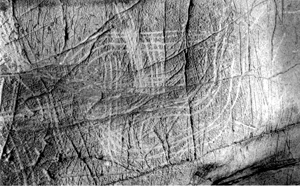
Prehistoric Use of Caves
More than seven thousand deep caves have been recorded throughout Tennessee. Concentrated in the limestone uplands of Middle and East Tennessee, these karsts extend from the Mammoth Cave area of central Kentucky through Tennessee into northern Alabama, and they represent one of the most extensive cave systems in the world. Ancient Native Americans took note of these caves, incorporated them into their world view, and used them in a variety of ways.
There is no evidence that prehistoric peoples ever lived in the “dark zones” of deep caves beyond external light. Occupations did occur in open rockshelters and in cave vestibules, but the deeper recesses were clearly considered unsuitable for habitation. Deep caves were used for more specialized purposes. Dr. Patty Jo Watson, a leading cave archaeologist, defines four types of sites based on variation in ancient underground activities. These are footprint caves, mortuary caves, mines and quarries, and ceremonial caves. All four types are found in Tennessee.
Footprint caves preserve the imprints of human feet in mud or soft sediments and are often associated with very limited archaeological debris, suggesting ephemeral, exploratory visits to the dark zone. Charcoal from ancient torches sometimes found with the footprints allows them to be dated; in several cases, footprints may be older than 4,000 years, indicating that Archaic hunter-gatherers (8000 B.C.-1000 B.C.) were willing and able to penetrate Tennessee’s karst systems. Hundreds of prints might be present in a given cave, evidence for the presence of groups of people of varying ages and/or sexes. Caves where only footprints and torch charcoal are found bear witness to ancient cave exploration as a specific activity, but footprints also occur in mining and ceremonial caves. Ancient footprints are extremely fragile, and many have been obliterated by later, including modern, cave traffic.
Mortuary caves are holes in the ground into which human bodies, intact or cremated, were introduced for inhumation. There may be hundreds of these sites in Tennessee, but very few have been studied out of respect for their dead. Some have been examined when looters have illegally exhumed or molested the human remains. At least two sites associate petroglyphs, or cave art, with burials. In Alabama, Kentucky, and Virginia, where burial caves have been researched in detail, this practice seems to be related to the Woodland Period (1000 B.C.-A.D. 1000) as initial agricultural communities were developing. The chronology of mortuary caves in Tennessee is unknown.
Mines and quarries are well known from Kentucky and Indiana, where caves were mined during the Woodland Period for minerals, especially crystalline salts (epsomite, gypsum, aragonite and mirabilite). These minerals might have been ingested for ceremonial or medicinal purposes and were probably traded among Woodland agricultural villages. No direct evidence for mineral mining has been found in Tennessee, although residues of these materials have been recovered from prehistoric containers, making it likely that such mining did occur. Chert quarries in caves are common in Tennessee, and these have been dated from the Archaic, through the Woodland, into the Mississippian (A.D. 1000-1600) Periods. In one case, a Late Archaic chert mine was located more than a kilometer from the cave’s mouth. It is also likely that clay was removed from some caves for use in ceramic production or as pigment.
Historical Native American groups in the Southeast saw caves as pathways to the underworld, which was an enigmatic and even dangerous world. Prehistoric ceremonial activity is evident in a number of caves in the form of cave art. This is the only dark zone cave art tradition known from prehistoric North America. Images of religious import are incised into rock (petroglyphs), painted (pictographs), and engraved into wet clay (mud glyphs). The great majority of cave art was produced in the Mississippian Period, but some sites may be Woodland and even Archaic in age.
Cave use by prehistoric peoples involved a variety of activities and changed over time. In the Archaic, caves were explored, mined, and decorated with art. The same range of activities occurred during the Woodland Period, with the probable use of pit caves for burial; mining of mineral salts was emphasized. Mississippian peoples decorated caves and may have performed limited mining. Tennessee’s vast karst systems were an important part of the prehistoric landscape.
Suggested Reading
Kenneth C. Carstens and Patty Jo Watson, eds., Of Caves and Shell Mounds (1996); Charles H. Faulkner, ed., The Prehistoric Native American Art of Mud Glyph Cave (1986); Patty Jo Watson, ed., The Archaeology of the Mammoth Cave Area (1974)



